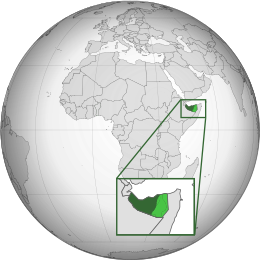Commons:Szerzői jogi szabályok területenként/Szomáliföld
|
Szerzői jogi szabályozás: Szomáliföld elhelyezkedése Szomáliában Rövidítés: COM:SZOMÁLIFÖLD ELHELYEZKEDÉSE SZOMÁLIÁBAN | |
 | |
 | |
| Védelmi idők | |
|---|---|
| Általános | Life + 30 years |
| Egyéb | |
| Szokásos licencsablonok | {{PD-Somaliland}} |
| Szerződések | |
| URAA restoration date* | Not recognized |
| *Egy mű jellemzően jogvédett az Egyesült Államokban, ha olyan típusú mű, ami általánosságban jogosult a szerzői jogi védelemre az USA-ban, 1928. december 31. után hozták nyilvánosságra, és jogvédett volt a származási országában az URAA-dátumon. | |
Szomáliföld Észak-Szomáliában helyezkedik el. Az állam vezetői 1991-ben kiáltották ki függetlenségüket, de nemzetközileg Szomália autonóm területének tekintik.
Background
A 19. század végén a brit és olasz birodalmak kijelölték Brit Szomáliföld és Olasz Szomáliföld területét. Az olasz részt 1941-től egy brit militarista vezetés uralta. 1949-ben Olasz-Szomáliföld olasz vezetéssel ENSZ-gyámterület lett. A két régió 1960. július 1-ji egyesülésével létrejött a független Szomáliai Köztársaság, majd 1991. május 18-án a korábbi brit fennhatóságú terület önhatalmúlag kikáltotta a függetlenséget.
A brit oldalon a 1911 Copyright Act, majd később a Copyright Act 1956, az olasz oldalon pedig az olaszországi jogszabályok voltak érvényben. A két különálló törvénykönyv 1977-ig volt érvényben, amikor a független Szomália elfogadta első szerzői jogi törvényét (Copyright Law, Law No. 66 of 7 September 1977).[1] Az 1977-es törvény betartását nem ellenőrzik széles körűen, és azt sem tudni, Szomáliföldön mennyire érvényesek az abban foglaltak.[1]
Somaliland and Somalia are not signatory to the Berne Convention or any treaty with the United States, so works from Somaliland may be freely used in the United States. To qualify for Wikimedia Commons they must also be free of copyright in Somaliland. Given the uncertain status, under the precautionary principle they must be free of copyright under the law of Somalia and the law of Somaliland.
General rules
According to the 1977 Copyright Law - Law No. 66 of 7 September 1977, Somali law includes copyright protection only for registered works. However, there is no longer anywhere to register copyrights. There are records of a copyright office existing prior to being destroyed in the civil war in 1991. Durations were:
- The copyright of (registered) literary and artistic and scientific works shall be protected during the life of the author and for a further period of 30 years after his death.[6/1977 (Art.24)]
- In the case of joint works, the copyright shall be protected up to 30 years after the death of the last surviving author.[6/1977 (Art.24.2)]
- Works whose authors are not known or were published anonymously or under pseudonyms shall enjoy protection from the date when the unknown name or the real name of the author is found in the Copyright Register.[6/1977 (Art.25)]
- Works undertaken after the death of an author shall enjoy protection from the date of their publication.
Treaty status
 |
Per U.S. Circ. 38a, the following countries are not participants in the Berne Convention or Universal Copyright Convention and there is no presidential proclamation restoring U.S. copyright protection to works of these countries on the basis of reciprocal treatment of the works of U.S. nationals or domiciliaries:
As such, works published by citizens of these countries in these countries are usually not subject to copyright protection outside of these countries. Hence, such works may be in the public domain in most other countries worldwide. However:
Somaliland has no effective copyright protection, active copyright protection, or international copyright treaties. According to the 1977 Copyright Law - Law No. 66 of 7 September 1977, the law of internationally recognized Somalia includes copyright protection for registered works. However, there is no longer anywhere in Somaliland to register copyrights. There are records of a copyright office existing prior to being destroyed in the civil war in 1991. |
Copyright tags
Lásd még: Commons:Licencsablonok
Freedom of panorama
Lásd még: Commons:Panorámaszabadság
- De facto:
 Unsure. See also: Commons:Copyright rules by territory/Somalia#Freedom of panorama.
Unsure. See also: Commons:Copyright rules by territory/Somalia#Freedom of panorama.
Lásd még
Jegyzetek
- ↑ a b Somaliland Copyright Law. Somaliland Law.com (2018). Retrieved on 2018-12-09.
- ↑ Somali Democratic Republic Copyright Law 1977: Law No. 66 of 7/9/1977 (in Somali). Retrieved on 2020-12-21.